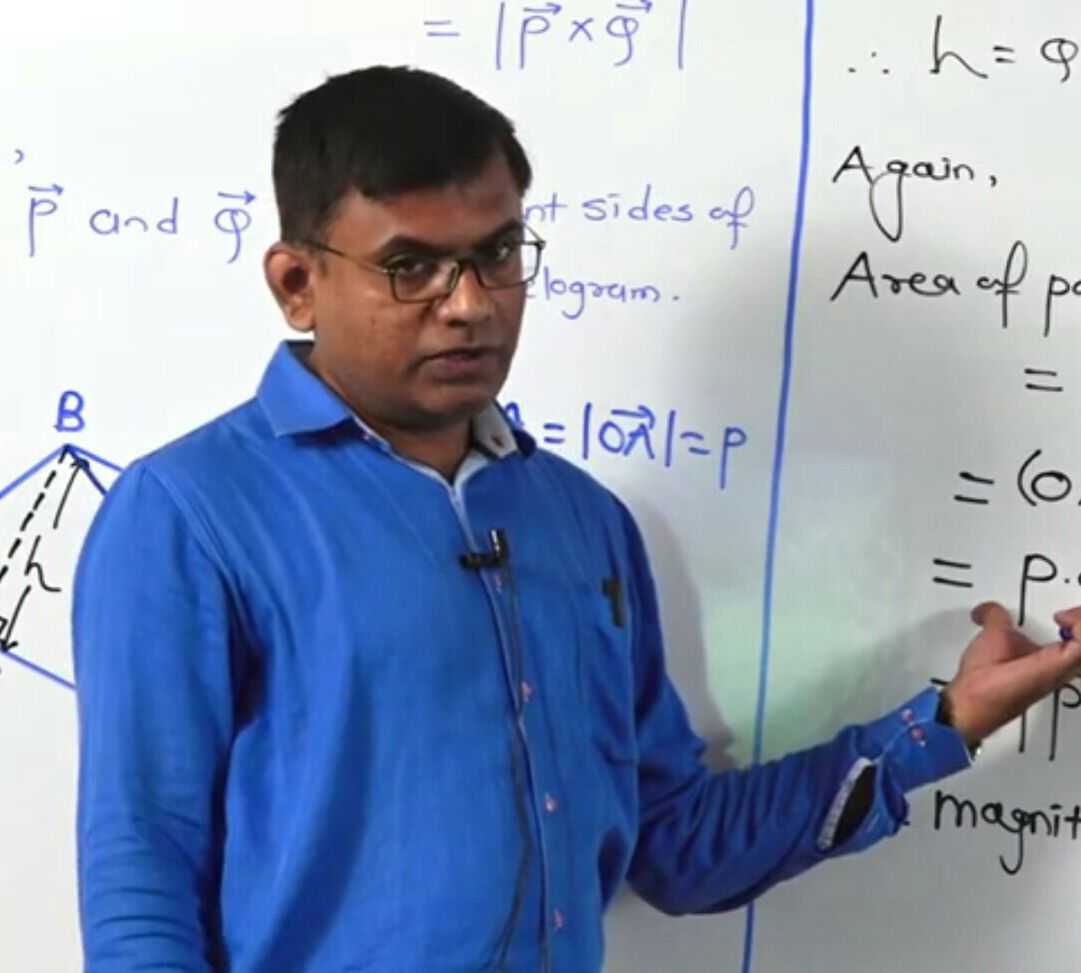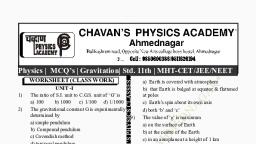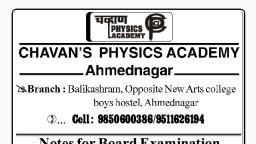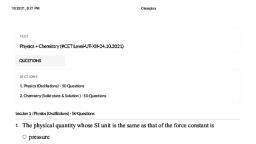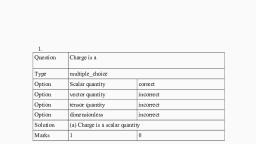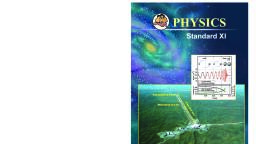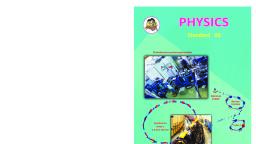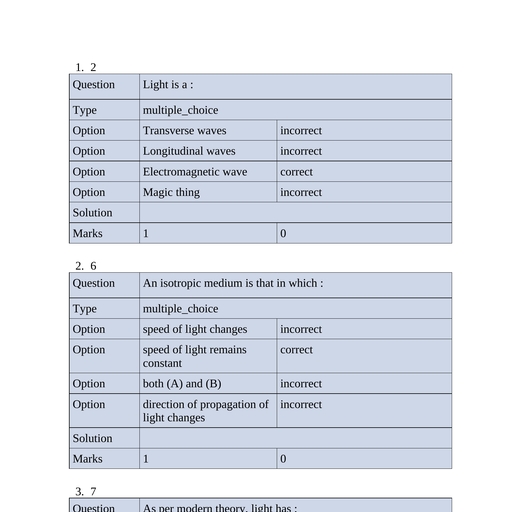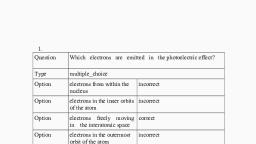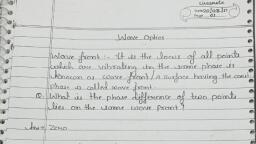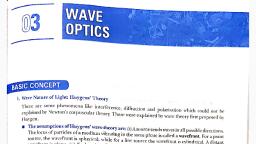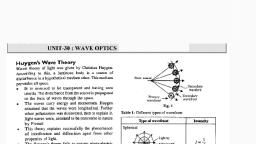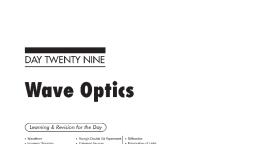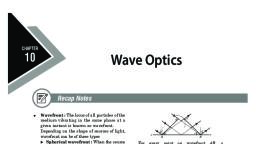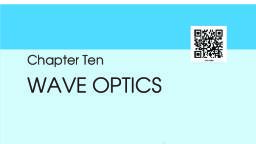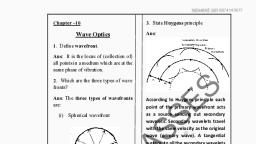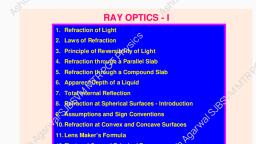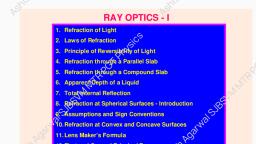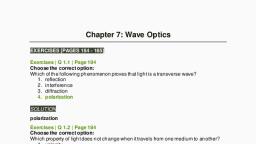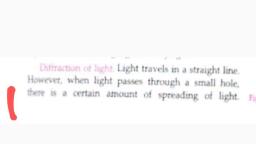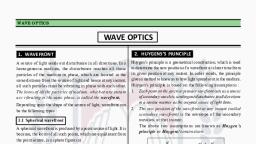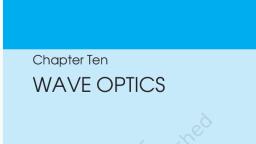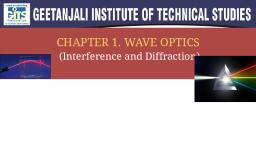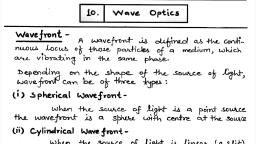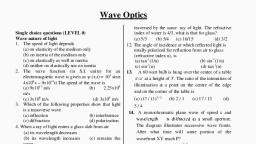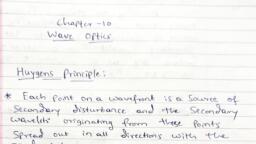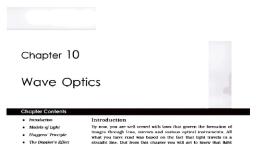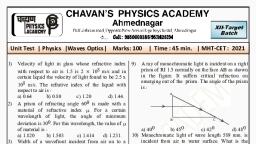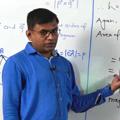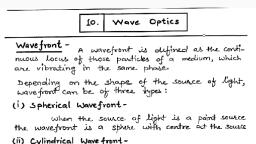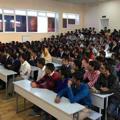Page 2 :
PART-I, , Excellent Notes, , Waves Optics, , WAVES OPTICS, Q.1. i) What does the formation of shadows tell you, about the propagation of light?, Ans: Light cannot pass through opaque objects. Also, light, travels in straight line i.e., rectilinear motion., ii) What are laws of reflection and refraction?, Ans : Laws of reflection:, a., Reflected ray lies in the plane formed by incident ray, and the normal drawn at the point of incidence; and, the two rays are on either side of the normal,, b., Angles of incidence and reflection are equal (i = r)., Laws of refraction:, a., Refracted ray lies in the plane formed by incident ray, and the normal drawn at the point of incidence; and, the two rays are on either side of the normal,, b., Angle of incidence ( 1) and angle of refraction ( 2), are related by Snell's law, given by,, n1 sin 1 = n2 sin 2, where, n1, n2 = refractive indices of medium 1 and, medium 2 respectively., iii. What are electromagnetic waves?, Ans: Waves that are caused by the acceleration of charged, particles and consist of electric and magnetic fields, vibrating sinusoidally at right angles to each other and, to the direction of propagation are called, electromagnetic (EM) waves or EM radiation., iv. What is the range of frequencies of visible light?, Ans: Range of frequencies of visible light is from, 4 × 1014 Hz to 7.9 × 1014 Hz., v., What is meant by the phase at a point along the, path of a wave?, Ans: Phase at a point along the path of a wave for a particle, is its state of vibration or oscillation., Q.2. What is ray optics?, Ans: The study of optical, phenomena under the, assumption that it travels in a straight line as a, ray is called ray optics or geometrical optics, Q.3. State postulates of Newton's corpuscular theory., Ans : Postulates of Newton's corpuscular theory:, i., Light is made up of particles, i.e., corpuscles which, are hard, elastic and massless., ii., A source of light emits these corpuscles which travel, along straight lines in the absence of any external force., iii. When the light corpuscles strike a reflecting surface,, they undergo elastic collisions and as a result follow, the law's of reflection,, For -NEET, Medical, Std. Board, , 2, , iv., , During refraction, it is the difference in the attractive, force between the corpuscles and the particles of the, medium that causes a change in the direction of the, corpuscles,, , v., , A denser medium exerts a larger attractive force on, light corpuscles to accelerate them along the normal, to the boundary,, , vi., , Light of different colours corresponds to corpuscles, of different sizes., , Q.4. State drawbacks of Newton's corpuscular theory., Ans: Drawbacks of Newton's corpuscular theory:, i), , The theory predicted that speed of light i in a denser, medium is more than the speed of light in a rarer, medium which was experimentally proved wrong., Hence Newton's corpus theory was rejected., , ii), , It could not explain phenomena such as interference,, diffraction or polarisation of light., , Q.5. What is wave optics?, Ans: The branch of optics which uses wave nature of light, to explain the optical phenomena is called wave, optics., Q.6. State main postulates of Huygens wave theory, of light., Ans: Main postulates of Huygens' wave theory:, i), , Light energy from a source is propagated in the form, of waves,, , ii), , To explain the propagation of light waves through, vacuum, Huygens suggested the Existence of, hypothetical medium called 'ether'., , Q.7. State the merits of Huygens' wave theory of light., Ans : Merits of Huygens' wave theory of light:, i), , It gives satisfactory explanation for laws of reflection, and refraction of light and formation of images by, mirrors and lenses assuming wave feature of the light., , ii), , It also explains the phenomena of interference,, diffraction., , iii), , It proved that velocity of light in rarer medium is greater, than that in a denser medium., , Q.8. State demerit of Huygens' wave theory of light., Ans : Demerit of Huygens' wave theory of light:, i), , According to Huygens' wave theory; ether medium, exists everywhere in the universe. However,, Michelson's and Morley's theory Disapproved the, existence of ether medium., , Physics
Page 3 :
Excellent Notes, , PART-I, , ii), , Huygens' theory is an empirical theory. It just assume, that the backward travelling waves will not be effective, which is incorrect., iii) Polarisation can not be explained., Q.9. Why does geometrical optics work in case of, formation of shadows, reflection, refraction but, fail in case of phenomenon such as interference,, diffraction etc?, Ans :, i), , ii), , Secondary sources:, i) Secondary sources are those sources which do, not produce light of their own but receive light from, some other source and either reflect or scatter it, around. Examples: the moon, the planets, objects,, ii. In our daily life majority sources are secondary, sources,, iii. Most secondary sources are extended sources., Q.13. Define and explain phase of a wave., , Geometrical optics works in case of formation of, shadows, reflection and refraction because the, wavelength of light is much smaller than the reflecting, or refracting surfaces as well as the shadow causing, objects that one encounters in laboratory or in dayto-day life., , Ans: The phase of the wave at a point is defined by the, state of motion of the particle at that point as well as, the distance of the point from the source., Explanation:, Two particles are said to be in phase, (have the same, phase) if their state of motion is the same. This means, they have the same velocity and displacement, perpendicular to the wave surface and they are at the, same distance from the source., , But it fails as obstacles used in interference, diffraction, etc. has size comparable to wavelength of light., , Q.10. What is dual nature of light?, Ans: Light can exhibit particle nature as well as wave nature, under different situations. This nature of light is termed, as dual nature., Q.11. Discuss properties of light., , Q.14. What is wavefront?, Ans: The locus of all points having the same phase at a, given instant of time is called a wavefront., Q.15. What is a spherical wave?, , Ans :, i), , Light is an electromagnetic wave. These waves are, transverse in nature and consist of tiny oscillating, electric and magnetic fields which are perpendicular, to each other and to the direction of propagation of, the wave., , ii), , Light does not require any material medium for, propagation and can even travel through vacuum., , iii), , Waves Optics, , The speed of light in a material medium (v) depends, on the refractive index of the medium (n) which, in, turn, depends on permeability and permittivity of the, medium., , Ans: Three dimensional waves like the sound waves, produced by a source of sound, or light waves, produced by a light source, travel in all directions away, from the source and propagate in three dimensions., Such a wave is called a spherical wave., Q.16. Explain what is a spherical wavefront., Ans:, i), , Ex: Candle flame produces spherical wavefront., ii), , It is a surface passing through all points having the, same distance from the source and having the same, phase,, , iii), , In case of light they are spheres centred on the source, say at O, the cross sections of which are as shown, below:, , Q.12.What are primary and secondary sources of light?, Ans: Primary sources:, i) Primary sources are sources that emit light of their, own, due to, a) Their high temperature (examples: the Sun, the, stars, objects heated to high temperatures, flame, of any kind, etc),, , A wavefront originating from a point source of light, at finite distance is called spherical wavefront., , b. The effect of current being passed through them, (examples: tube light, TV, etc.)., c. Chemical or nuclear reactions (examples:, firecrackers, nuclear energy generators),, ii), , Spherical wavefronts corresponding to, diverging beam of light., , Light originates in these sources., , For -NEET, Medical, Std. Board, , 3, , Physics
Page 4 :
Excellent Notes, iv), , PART-I, , Circles seen in figure are basically cross-sections of, spherical wavefront with source at their centre. The, arrows are perpendicular to the spherical surfaces and, show the direction of propagation of the waves. The, wavefronts shown in the figure correspond to a, diverging beam of light., , Q.17. Draw wavefronts corresponding to beam of light, after passing through a convex lens., Ans: Wavefront corresponding to converging beam of light., , Waves Optics, , Q.23. State Huygens' principle., Ans: Statement: Each point on a wavefront acts as a, secondary source of light emitting secondary light, waves called wavelets in all directions which travel, with the speed of light in the medium. The new, wavefront can be obtained by taking the envelope of, these secondary wavelets travelling in the forward, direction and is thus, the envelope of the secondary, wavelets in forward direction. The wavelets travelling, in the backward direction are ineffective., Q.24. Explain the Huygens' construction of spherical, wavefront., Ans:, , Q.19. How is wavefront related to rays of light?, Ans: Rays of light indicate direction of propagation of light, wave. The direction of propagation of the wave is, perpendicular to the wavefronts, i.e., the rays of light, are always perpendicular to wavefront., Q.20. What is the shape of the wavefront at a point far, away from the source of light?, Ans: Plane., Q.21. Explain formation of plane wavefront., Ans:, i), Consider a spherical wavefront which has travelled, a large distance away from the source,, ii), If a small portion of this wavefront is taken, it will, appear to be a plane surface with the direction of, propagation perpendicular to it., iii) In such a case the wave is called a plane wave., Wavefronts for a plane wave are shown below:, , Plane wavefronts corresponding to parallel, beam of light., iv) Here, the arrows (rays) which after traversing large, distance have now become parallel correspond to a, parallel beam of light., Q.22. What is the shape of the wavefront if the source, of light is linear, say, a tube light?, Ans: Cylindrical., For -NEET, Medical, Std. Board, , 4, , i), , Spherical wavefront is formed when source of light is, at a finite distance from point of observation., , ii), , Let S be the point source of light in air. PQR represents, spherical wavefront at any instant. The wavefront PQR, acts as a primary wave which is propagated through, air., , iii), , According to Huygens' principle, all the points on PQR, will act as secondary sources of light and send, secondary wavelets with same velocity 'c' in air in, forward direction as backward travelling wavelets are, supposed to be ineffective., , iv), , New wavefront at a later instant 't' will be envelope of, hemispherical wavelets with P, Q, R.... as centres and, 'ct' as radius in the forward direction., , v), , The surface tangential to all such hemispheres is an, envelope at that instant 't'. Such a surface is passing, through the points P1, Q1, R1 ....on the hemispheres, and touching all the hemispheres. This surface is the, new wavefront at that instant 't'., , vi), , SPN, SQN 2, and SRN 3 show the direction of, propagation of spherical wavefront., , vii), , The new wavefront P1Q1R1 is parallel to PQR at, every instant., , Physics
Page 5 :
Excellent Notes, , PART-I, , Q.25. Explain the Huygens' construction of plane, wavefront., Ans:, i), A plane wavefront is formed when point of, observation is very far away from the primary source., ii), Let PQR represent a plane wavefront at any instant., According to Huygens' principle, all the points on this, wavefront will act as secondary Sources of light, sending out secondary wavelets in the forward, direction as backward travelling wavelets are, supposed to be ineffective., iii) Draw hemispheres with P, Q, R.... as centres and 'ct', as radius. The surface tangential to all such, hemispheres is P1Q1R1.... at instant 't'. It is a new, wavefront at time 't'., iv) The plane wavefronts are propagated as plane waves, in medium. They are parallel to each other., , Waves Optics, XY : Plane reflecting surface, AB : Plane wavefront RBi: Reflecting wavefront, A1M, B1N : Normal to the plane, AA1M1= BB1N =, , i = Angle of incidence, , TA1M= QB1N= r = Angle of reflection, Explanation:, i), , A plane wavefront AB is advancing obliquely towards, plane reflecting surface XY. AA1 and BB1 are incident, rays., , ii), , When 'A' reaches XY at A1, then ray at 'B' reaches, point 'P' and it has to cover distance PB1 to reach the, reflecting surface XY., , iii), , Let 't' be the time required to cover distance PB1., During this time interval, secondary wavelets are, emitted from A1 and will spread over a hemisphere of, radius A1R, in the same medium. Distance covered, by secondary wavelets to reach from A1 to R in time, t is same as the distance covered by primary waves, to reach from P to B1. Thus A1R = PB1 = ct., , iv), , All other rays between AA1 and BB1 will reach XY, after A1 and before B1. Hence, they will also emit, secondary wavelets of decreasing radii., , v), , The surface touching all such hemispheres is RB1 which, is reflected wavefront, bounded by reflected rays A1R, and B1Q., , vi), , Draw A1M, , PQR: Plane wavefront at any instant,, P1Q1R1: Plane wavefront after time 't', v), PP1 N1 , QQ 1N 2, RR1N 3 show the direction of vii), propagation of plane wavefront., vi) The new wavefront P1Q1R1 is parallel to primary, wavefront PQR., Q.26. Derive the laws of reflection of light using, Huygens’ principle., , XY and B1N, , XY., , Thus, angle of incidence is AA1M = BBiN = i, and angle of reflection is MA1R = NB1Q = r., RA1B1 = 90 – r and PB1A1 = 90 – i, In A1RB1 and A1PB1, A1RB1, , A1PB1=90º, , A1R = PB1 (Reflected waves travel equal distance in, same medium in equal time)., A1B1 = A1B1, , .......(common side), , A1RB1, , A1PB1, , RA1B1, , PB1A1, , 90 – r = 90 – i, i=r, , For -NEET, Medical, Std. Board, , 5, , viii), , Also, from the figure, it is clear that incident ray,, reflected ray and normal lie in the same plane., , ix), , This explains laws of reflection of light from plane, reflecting surface on the basis of Huygens' principle., , Physics
Page 6 :
Excellent Notes, , PART-I, , Q.28. Derive the laws of refraction of light using, Huygens' principle., , ii), , Also, comment about nature of image formed., Ans:, , Waves Optics, Similarly, NA1R = N1B1R1 = r, We have, N1B1R1 + N1B1R = 90º, , .......(3), , and N1B1R + A1B1R = 90º, , ........(4), , From equations (3) and (4),, N1B1R1 =, , A1B1R = r, , iii), , In A1RB1, sin i =, , .......(5), , iv), , In A1RB1, sin r =, , ........(6), , v), , Dividing equation (5) by (6),, , Refraction of light, Explanation:, i), , ii), , Let XY be the plane refracting surface separating, two media air and glass of refractive indices n1 and, n2 respectively., , .........(7), 2, , A plane wavefront AB is advancing obliquely towards, XY from air. It is bounded by rays AA1 and BB1 which, are incident rays., , iii), , When 'A' reaches 'A1', then 'B' will be at 'P'. It still, has to cover distance PB1 to reach XY., , iv), , According to Huygens' principle, secondary 'wavelets, will originate from A1 and will spread over a, hemisphere in glass., , v), , All the rays between AA1 and BB1 will reach XY and, spread over the hemispheres of decreasing radii, in glass. The surface of tangency of all such, hemispheres is RB1. This gives rise to refracted, wavefront B1R in glass., , vi), , A1R and B1R1 are refracted rays., , vii), , Let c1 and c2 be the velocities of light in air and glass, respectively., , viii), , At any instant of time 't', distance covered by incident, wavefront from P to B1 = PB1 = c1t, Distance covered by secondary wave from A1 to R =, A1R = c2t, , Also,, , c2, , n1, , .........(8), , 1, , vi), , From the explanation, it is clear that incident rays AA1,, BB1, refracted rays A1R, B1R1 and normal MN and, M1N1 lie on the same plane XY. Also, incident ray, AA1 and refracted ray A1R lie on opposite sides of, normal MN. Hence, laws of refraction can be, explained., , vii), , If c1 > c2, i.e., n1 < n2. Then i > r. Thus, during oblique, incidence, the refracted ray will bend towards the, normal while going from an optically rarer (smaller, refractive index) to an optically denser (higher refractive, index) medium. While entering an optically rarer, medium form a denser medium, the refracted ray will, bend away from the normal., , Proof of laws of refraction:, i), , From figure,, AA1M + MA1P = 90°, and, , MA1P + PA1B1 = 90°, , .......(1), .......(2), , From equations (1) and (2),, AA1M = PA1B1 = i, , For -NEET, Medical, Std. Board, , 6, , Physics
Page 7 :
PART-II, , Excellent Notes, , Waves Optics, , WAVES OPTICS, Q.29. Explain what is meant by polarization., Ans: The phenomenon of restriction of the vibration of, light waves in a particular plane perpendicular to, direction of wave motion is called polarisation of, light., Q.30.Define unpolarised light. Give its symbolic, representation., Ans :, A light in which the vibrations of the electric vectors, are in all possible directions, which are perpendicular, to the directions of propagation, is called as, unpolarised light. Symbolic representation of, unpolarised light is as shown in figure., , Q.31. Define plane polarised light. Represent it, symbolically., Ans: The light waves in which vibrations of the, electric field vectors are confined only to one plane, are called plane polarised light., Representations of a plane polarised beam, travelling perpendicular to plane of paper., Polarized light with electric field along the, horizontal direction., Q.32. State methods to produce plane polarised light., Ans: Plane polarised light can be produced by:, (i) reflection, (ii) scattering, (iii) refraction, (iv) polaroid., Q.33. (i) What are polarizers? What is a polaroid and the, polarizing axis of the polarizer?, (ii) Define plane of vibration and plane of polarization., Ans :, i), (a) Certain types of materials which allow only, those light waves which have their electric field, along a particular direction to pass through and, block all other waves (which have their electric, field in other directions) are called polarizers., (b)A polaroid is a kind of synthetic plastic sheet, which is used as polarizer., For -NEET, Medical, Std. Board, , 7, , (c), , The particular direction along which the electric, field of the emergent wave is oriented is called thepolarizing axis of the polarizer., ii), (a) Plane of vibration: The plane in which the, vibrations of polarised light take place is called, as plane of vibration., (b) Plane of polarisation: The plane perpendicular, to the plane of vibration in which there are no, vibrations of polarised light is called as plane of, polarisation., Q.34. Show that the intensity of an unpolarised wave, reduces by half after passing through a polarizer., Ans:, i), Consider an unpolarized wave having angular frequency, co and wave vector k, travelling along the X-direction., ii), The magnitude of its electric field is E = E0 sin, (kx – t), E0 being the amplitude of the wave and, direction of the electric field can be anywhere in the, Y-Z plane. The intensity (I) of the wave will be, proportional to |E0|2., iii) Consider a particular wave having its electric field at, an angle to the axis of the first polarizer., iv) The component E0 cos will pass through the first, polarizer while the normal component E0 sin will be, obstructed., v), The intensity of this particular wave after passing, through the polarizer will be proportional to the square, of its amplitude, i.e., to |E0 cos )|2., vi) For unpolarized incident wave, can have all values, from 0° to 180°., vii) Thus, to get the intensity of the plane polarized wave, emerging from the first polarizer, we have to average, |E0 cos |2 over all values of between 0° and 180°., 2, , 2, 0, , ...., , This means, the intensity of an unpolarised wave, reduces by half after passing through a polarizer., Q.35. Derive Malus' law., Ans :, i), Consider the linearly polarized wave (electric field, vectors are confined to one plane and in unique, direction) emerging from first polarizer., ii), , If the polarized wave.has its electric field E1 along, the Y-direction as shown in the figure below. Then the, electric field is,, , Physics
Page 8 :
Excellent Notes, , PART-II, , Waves Optics, , ii), , You look at the source through two, polarizers and rotate one of them around the path, iii) The intensity of the polarized wave is given by, of light for one full rotation?, 2, ........(2) Ans: a. When axes of polarization of two polarizers are, parallel, intensity of light observed will be, maximum. It will reduce to become zero at half, rotation as second polarizer is rotated and axes of, polarization of two polarizers become, perpendicular to each other,, b. As second polarizer is rotated further, intensity, slowly increases and 'becomes maximum as, axes of polarizations of two polarizers become, parallel again., iii) Instead of rotating only one of the polaroids, you, Unpolarized light passing through two polarizers, rotate both polaroids simultaneously in the same, iv) Now if this wave passes through second polarizer, direction?, whose polarization axis makes an angle with the Ydirection, only the component E10 cos will pass Ans: Intensity of light as observed initially will remain, constant throughout., through., v), Thus, the amplitude of the wave which passes through Q.38. Explain why only transverse waves can be, polarized while longitudinal waves cannot be, (say E20) is now E10 cos and its intensity I1 will be, polarized., 2, Ans:, i), In transverse waves, such as light, the oscillations can, be along any direction in a plane which is, perpendicular to the direction of propagation of the, ........(3), wave., This is known as Malus' law which gives the intensity, By restricting the oscillations to be along only one, of a linearly polarized wave after it passes through a ii), direction in this plane, we get a plane polarized wave., polarizer., Q.36. Discuss parallel and cross setting of two iii) For longitudinal waves, such as the sound wave, the, particles of the medium oscillate only along one, polarizers., direction, which is the direction of propagation of the, Ans:, wave. Thus, oscillations take place in restricted plane, i), Parallel setting:, by its nature. Hence, only transverse waves can be, a. When angle between axes of polarization of two, polarized while longitudinal waves cannot be polarized., polarizers ( ) is zero, setting is said to be parallel, setting., Q.39. What is Brewster's law? Derive the formula for, b. In this case, the polarization axes of the two, Brewster angle., polarizers are parallel hence the intensity does not Ans: Brewster's law is based upon phenomenon of, change while passing through the second polarizer., polarization by reflection. Statement: The tangent of, ii), Cross setting:, the polarising angle is equal to the refractive index of, a. When angle between axes of polarization of two, the refracting medium at which partial reflection takes, polarizers ( ) is 90°, setting is skid to be crossplace., setting., b. For = 90°, cos2 = 0 and according to Malus', According to Brewster's law, tan, law, no light emerges from second polarizer., n1, Q.37. What will you observe if,, where, n1 and n2 are refractive indices of two media., i), You look at an unpolarized source of light through, Derivation of Brewster angle:, a polarizer?, When light is incident at an angle on a boundary, Ans: When an observer looks at an unpolarised source of i), between, two transparent media having refractive, light through a polarizer, he sees light of less (half), indices n1 and n2, part of it gets refracted and the rest, intensity., gets reflected,, ......(1), , For -NEET, Medical, Std. Board, , 8, , Physics
Page 9 :
Excellent Notes, ii), , Consider unpolarized light incident from rarer medium, of refractive index n1 on such a boundary that is, perpendicular to the plane of the paper, as shown, below,, , iii), , For a particular angle of incidence B (shown in the', figure), the reflected wave is completely plane, polarized with its electric field perpendicular to, the plane of the paper while the refracted wave is, partially polarized. This particular angle of incidence, is called the Brewster's angle ( B)., For this angle of incidence, the refracted and reflected, rays are perpendicular to each other., For angle of refraction r,, + r = 90°, .......(1), B, From laws of refraction,, n1 sin B = n2 sin r, n1 sin B = n2 sin( 0 – B), .... [Using (1)], , iv), , n1, , This is the expression for Brewster's angle., Q.40.Explain an application of polarization by, reflection., Ans:, i), The phenomena of polarization by reflection is used, to cut out glare from the reflecting surfaces using, special sunglasses., ii), Sunglasses are fitted with polaroid which reduce the, intensity of the partially or fully polarized reflected light, coming to the eyes from reflecting surfaces., iii) The intensity of Sunlight or light coming from artificial, sources which is completely unpolarized is also, reduced to half by the polaroid., iv) This phenomenon of polarization by reflection works, only for non-metallic surfaces., For -NEET, Medical, Std. Board, , Waves Optics, , PART-II, , 9, , Q.41. Explain polarization by scattering., Ans:, i), When Sunlight strikes air molecules or dust particles, in the atmosphere, it changes its direction. This is called, scattering., ii), When Sunlight is scattered, it gets partially polarized, in a way similar to the reflected light., iii) The degree of polarization depends on the angle of, scattering, i.e., the angle between the direction of the, light incident on the molecule or dust particle and the, direction of the scattered light. If this angle is 90°, the, scattered light is plane polarized., iv) Thus, the scattered light reaching us from different, directions in the sky is polarized to different degrees., Q.42. Can you tell?, i), If you look at the sky in a particular direction, through a polaroid and rotate the polaroid around, that direction what will you see?, Ans: Observer sees sky getting bright and dim., ii), Why does the sky appear to be blue while the, clouds appear white?, Ans:, a., Blue colour of sky:, 1. When Sunlight enters the earth's atmosphere,, scattering of different colours take place due to, the presence of large number of air molecules and, then reaches the surface of earth., 2. The different wavelengths get scattered from their, path through different amounts obeying Rayleigh's, law of scattering., 3. Let r, b and v be the wavelengths of red, blue, and violet colours respectively and ( r > b> v)., 4. The size of molecules 'a' << . So, for blue and, violet colours, scattering is more than that for the, red colour. Our eyes are not very sensitive to violet, colour., 5. Let Ir and Ib be the intensities of the scattered light, of two colours (wavelerigths) respectively., According to Rayleigh's law of scattering,, Ib, , b., , and Ir, , As r 1.6 b, Ib 6Ir, the light reaching the earth's, surface is mostly blue., 6. Due to this, blue colour scatters more and the sky, appears blue., The clouds are generally white:, Large particles like dust and water drops present in, the lower layers of atmosphere do not scatter, aecording to Rayleigh's law of scattering. They scatter, light of all colours almost equally and hence the clouds, are white., , Physics
Page 10 :
Excellent Notes, , PART-II, , Q43. What is interference? Give its examples., Ans: Interference of light is defined as the modification in, the intensity of light (larger at some places and smaller, at some places) produced by the superposition of two, or more light waves., Examples: Appearance of colours in soap bubble,, colours in thin oil films on surface of water., Q.44. What is constructive and destructive, interference?, Ans :, i), Points where the crest of one wave coincides with the, crest of another wave and where the trough of one, wave coincides with the trough of another wave are, points with the maximum displacement. At these points, displacement is twice that for each wave. These are, points of constructive interference., ii) Points where the crest of one wave is coincident with, the trough of another are points jwith the zero, displacement. These are- points of destructive, interference., Q.45. What is meant by coherent sources? What are, the two methods for obtaining coherent sources, in the laboratory?, Ans: Two sources which emit waves of the same frequency, having a constant phase difference, independent of, time, are called coherent sources., Examples: Monochromatic light, laser light, etc., Methods to obtain coherent sources in, laboratory:, i), Lloyd's mirror: This is an extensively used device., The light from a source is made to fall at a grazing, angle on a plane mirror as shown in figure below., , ii), , Light partially falls directly on the screen and some, light falls after reflection. The reflected light appears, to come from a virtual source. Thus we get two, sources which are derived from a single source and, hence are coherent. They interfere to produce an, interference pattern., Fresnel Biprism : A biprism is a prism with vertex, angle of nearly 180°. It can be considered to be made, up of two prisms with very small refracting angle, ranging from 30' to 1°, joined at their bases. In, experimental arrangement, the j refracting edge of the, biprism is kept parallel to the length of the slit., Monochromatic light from a source is made to pass, through a narrow slit S as shown in figure below and, fall on the biprism., , For -NEET, Medical, Std. Board, , Waves Optics, , The two halves of the biprism form virtual images S1, and S2. These are coherent sources having obtained, from a single secondary source S. The two waves, coming from S1 and S2 interfere and form interference, fringes like that in Young's double slit experiment in, the shaded region as shown in the figure., Q.46. What is the importance of coherent sources in, obtaining interference?, Ans :, i), At any given point in space, at every instant of time,, there are light waves from multiple sources, overlapping one another. These must be interfering, but no interference pattern is seen., ii), This is because different sources emit waves of, different frequencies and different phase., iii) Hence, the interference pattern changes every instant, of time and no pattern is sustained over a significant, length of time to be seen., iv) For interference to be. seen over sustained periods,, two sources of light which emit waves of the same, frequency and the waves emitted by them are in phase, or have a constant phase difference between them,, i.e. coherent sources of light are needed., Q.47. Describe Young's double slit interference, experiment., Ans :, i), In Young's double slit interference experiment, a plane, wavefront is made to fall on an opaque screen AB, having two similar narrow slits S1 and S2., ii), The figure below shows a cross section of the, experimental set up and the slits have their lengths, perpendicular to the plane of the paper., , 10, , Young's double slit experiment, , Physics
Page 11 :
PART-II, , Excellent Notes, , The slits are about 2-4 mm apart from each other., An observing screen PQ is placed behind of AB., Assuming that the slits S1 and S2 are equidistant from, the S, the wavefronts starting from S and reaching the, S1 and S2 at every instant of time are in phase., vi) When the rays fall on S1 and S2, the two slits act as, secondary sources of light emitting cylindrical, wavelets (with axis along the slit length) to the right of, AB., vii) The two secondary sources emit waves in phase with, each other., viii) The crests/troughs of the secondary wavelets, superpose as shown in the figure and interfere, constructively high intensity giving rise to bright, band., ix) When the crest of one wave coincides with the trough, of the other causing zero intensity, .dark images of the, slits are produced on the screen PQ., x), The dark and bright regions are called fringes and the, whole pattern is called interference pattern., Q.48. Derive conditions for occurrence of dark and, bright fringes on screen in Young's double slit, interference experiment. Define fringe width and, derive formula for it., Ans :, i), Let S1 and S2 be the two coherent monochromatic, sources which are separated by short distance d., They emit light waves of wavelength ., ii), Let D = horizontal distance between screen and, source., iii) Draw S1M and S2N AB, OP = perpendicular bisector of slit., Since S1P = S2P, the path difference between waves, reaching P from S1 and S2 is zero, therefore there, is a bright point at P., iv) Consider a point Q on the screen which is at a distance, y from the central point P on the screen. Light waves, from S1 and S2 reach at Q simultaneously by covering, path S1Q and S2Q, where they superimpose., , Waves Optics, , iii), iv), v), , .......(2), Subtract equation (1) from (2),, , + yd(S2Q)2 – (S1Q)2, = 2yd, (S2Q + S1Q) (S2Q – S1Q) = =2yd, 2yd, , S2Q – S1Q =, , .......(3), , If y << D and d << D , then S1Q S2Q D, S2Q + S1Q = 2D, Equation (3) becomes,, S2Q – S1Q =, , 2yd, 2D, , S2Q – S1Q =, , yd, D, , yd, ......(4), D, Equation (4) gives the path difference of two interfering, light waves. Point Q will be bright if,, , l=, , l = n = 2n, , 2, where n = 0, 1, 2,...., ynd, , .... [From equation (4)], .........(5), , Equation (5) represents distance of nth bright fringe, from central bright fringe., Point Q will be dark point if,, , Derivation:, In S1MQ, (S1Q)2 = (S1M)2 + (MQ)2, , l = (2n –1), , 2, where n = 1, 2, 3......., , .......(1), , y 'n d, , In S2NQ, (S2Q)2 = (S2N)2 + (NQ)2, For -NEET, Medical, Std. Board, , 11, , Physics
Page 12 :
Excellent Notes, , Waves Optics, , PART-II, , , where, n = ±1, ±2, , .......(6), , Equation (6) represents distance of n* dark fringe from Q.51. Distinguish between constructive and, destructive interference., central maximum., Ans:, Fringe width:, The distance between any two successive dark or any, No., Constructive, Destructive, two successive bright fringes is equal. This is called, Interference, interference, the fringe width and is given by,, i. The, resultant, The resultant, Fringe width = W = y = yn+1 – yn =, amplitude of, amplitude; of two, two waves is equal waves is equal to, to the sum of, the difference of, W=, amplitudes of, amplitudes, Thus, both dark and bright fringes are equidistant, individual waves of individual waves, and have equal widths., i.e., a = a1 + a2, i.e.,a = a1 – a2, Q.49. Explain effect of introducing a transparent plate, ii. The amplitude, The amplitude of, in front of slit upon interference pattern., of resultant, resultant wave is, Ans :, wave is, minimum., i), If a transparent plate of thickness t and refractive, maximum., index n is introduced front of slit S1 then the optical, iii. The path, The path, path travelled by the wave along S1Q is higher than, difference between difference between, that travelled by the wave along S1Q in absence of, two waves is an, two waves is i an, the plate by (n –l)t., even multiple of, odd multiple of, ii), Thus, the optical path lengths and therefore, the phases, 2, 2, of the rays reaching the midpoint P' from S1 and S2, will not be unequal., i.e., Δ = 2n, i.e., Δ / =(2n – l), 2, 2, iii) The path lengths will be equal at a point different, where,, where,, n=l,, 2,3, ......, than P' and so the bright fringe will not occur at P' but, n = 0, 1,2,3 ...., at a different point where the two optical path lengths, iv. The' crests or, The crest of one, are equal., roughs, of, two, wave, coincides, iv) The dark and bright fringes will be situated, waves coincide., with the trough of, symmetrically on both sides of this central fringe., another and] vice, Thus, the whole interference pattern will shift in one, versa., direction., Q.50. Derive condition for constructive and destructive Q.52. When two light waves of same intensity interfere,, interference in terms of phase difference,, find the resultant intensity of the waves. Discuss, assuming relation for path difference., resultant intensity when two waves interfere in, Ans: The relation between path difference ( l) and phase, phase and out of phase., difference, is given by,, Ans : Let two waves with phase difference meet at point, , The phase difference between the two waves reaching, P, from S1 and S2 is given by,, , P. Let their electric fields be,, E1 = E0 sin cot and E2 = E0 sin, Resultant electric field at P,, E = E0 sin t + E0 sin t +, , t+, , ......, The condition for constructive interference in terms of, phase difference is given by,, = n2 , where, n = 0, ± 1 ± 2, The condition for destructive interference in terms of, phase difference is given by, , For -NEET, Medical, Std. Board, , 12, , Since, here, amplitude is measured in terms of electric, field component of the wave, The amplitude of the, wave is,, , Physics
Page 13 :
Excellent Notes, , PART-II, , As Intensity I0 = a2 = E '0, Intensity at P,, , Case I:, When two waves which are in phase with each other, interfere,, =0, Resultant intensity,, IR = 4 I0 cos2, , = 0 = I = Imax, , Case II:, When two waves which are out of phase with each, other interfere,, Resultant intensity,, , Q.53 How will interference pattern change if, amplitudes of waves coming from two slits are, different?, Ans:, i), If amplitudes of waves coming from slits are different, such that they exhibit electric fields say (E1)0 and (E2)0, then, at centre of bright fringes amplitude will be (E1)0, + (E2)0 implying intensity to be proportional to, 2, , ii), , ., , At centre of dark fringes intensity will be proportional, 2, , to, . This means dark fringe will not, have zero illumination (i.e., totally dark) but will show, dim illumination., Q.54. What are the conditions for obtaining good, interference pattern? Give reasons., Ans: Conditions for obtaining sustaining and good, interference pattern are:, i), The two sources of light must be coherent:, Only two coherent sources can maintain their phase, relation necessary for sustained interference pattern., For -NEET, Medical, Std. Board, , Waves Optics, , For incoherent sources, emitted waves undergo rapid, and random cha nges and steady interference cannot, be obtained., ii), The two sources of light must be monochromatic:, a., The condition for bright and dark fringes, the position, of these fringes as' well as the width of the fringes, depend on the wavelength of light., b., Therefore, the fringes of different colours do not, coincide., c., The resultant pattern contains coloured, overlapping, bands due to their different wavelength., iii) The two interfering waves must have the same, amplitude:, Only if the amplitudes are equal, the intensity of dark, fringes (destructive interference) is zero and the, contrast between bright and dark fringes will be, maximum., iv) The separation between the two slits (d) must be, small in comparison to the distance between the, plane containing the slits and the observing, screen (D):, This is necessary as only in this case, the width of the, fringes will be sufficiently large to be measurable and, the fringes are well separated and can be clearly seen., v), The two slits should be narrow:, If the slits are broad, the distances from, different points along the slit to a given point on the, screen are significantly different and therefore,, the waves coming through the same slit will interfere, among themselves, causing blurring of the interference, pattern., vi) The two waves should be in the same state of, polarization:, This is necessary only if polarized light is used for the, experiment., Q.55. Explain what is optical path length. IJow is it, different from actual path length?, Ans:, i), When a wave travels a distance x through a medium, having refractive index of n, its phase changes by the, same amount as it would if the wave had travelled a, distance n x in vacuum., ii), Thus, a path length of x in a medium of refractive, index n is equivalent to a path length) of n x in vacuum., iii) n x is called the optical path travelled by a wave., iv) This means, optical path through a medium is the, effective path travelled by light in vacuum to generate, the same phase difference., v), Optical path in a medium can also be defined as the, corresponding path in vacuum that the light travels in, the same time as it takes in the given medium., , 13, , Physics
Page 14 :
Excellent Notes, , PART-II, viii), , vi), , Thus, a distance d travelled in a medium of refractive, index n introduces a path difference = nd – d = d, (n – 1) over a ray travelling equal distance through, vacuum., , Q.56. Why are 'multiple colours observed over a thin, film of oil floating on water? Explain with the help, of a diagram., The multiple colours observed over a thin oil films on, the surface of water are due' to the interference of, light waves reflected from the upper and lower surfaces, of the film., , ii), , Path difference between two rays depends on the point, on the film that is being viewed as jshown in figure, below:, , iii), , The incident wave gets partially reflected from lupper, surface as shown by ray AE. The rest of the light gets, refracted and travels along AB., , iv), , At B it again gets partially reflected and travels along, BC., , v), , At C it refracts into air and travels along CF., , vi), , The parallel rays AE and CF have a phase difference, due to their different path lengths in different media., , vii), , The phase difference depends on the angle of incidence, , i.e., the angle of incidence at the top surface, which, 1, is the angle of viewing, and also' on the wavelength of, the light as the refractive index of the material of the, thin film depends on it., , For -NEET, Medical, Std. Board, , The two rays AE and CF interfere, producing maxima, and minima for different colours at different angles of, viewing. Hence, one sees different colours when the, film is viewed at different angles., , Q.57. In Young's double slit experiment what will we, observe on the screen when white light is incident, on the slits but one slit is covered with a red filter, and the other with a violet filter? Give reasons, for your answer., Ans :, i), , Upon covering slits with two different coloured filters,, light emerging out of the two slits will not be, monochromatic., , ii), , For'sustained interference pattern, it is essential to have, monochromatic light., , iii), , Hence, interference will not be obtained on the screen, but red and violet coloured bands will be seen on the, screen., , Ans :, i), , Waves Optics, , 14, , Physics
Page 15 :
PART - III, , Excellent Notes, , Waves Optics, , WAVES OPTICS, Q.58. What is diffraction of light? How does it differ, from interference?, Ans: Definition:, The bending of light near the edge of an obstacle, or slit and spreading into the region of, geometrical shadow is called diffraction of light., Examples:, i), At noon, circular patches of Sunlight are seen on the, ground, when observed from underneath trees.,, ii), When sun is viewed through fine piece of cloth,, coloured spectra is observed due to diffraction of light,, iii) The luminous border surrounding the boundary of, mountain just before the sunrise or sunset is due to, diffraction of light., Difference between interference and diffraction:, No., i), , Interference, Interference is due to, superposition of, waves from different, wavefronts., , Diffraction, Diffraction is due to, many waves coming, from different parts of, the same wavefront., , ii), , All bright fringes are, of equal intensity., , iii), , Minimum intensity, may be zero., , Intensity decreases, with the order of, bright band., Minimum intensity is, not zero, , iv), , Width of the central, maximum is same as, that of other bright, fringes i.e fringe width, is same for all fringes, including central, maxima., The waves emitted by, two coherent sources, travel in straight line., , v), , vi), , The resolving power, of an optical, instrument does not, depend on the, phenomenon of, interference., , Width of central, maximum is broader, than other maxima and, it is double the fringe, width., , Set up for Fraunhofer diffraction, Emerging beam is incident on another converging lens, that focuses the beam on a screen., Q.61. Describe with neat diagram, the Fraunhofer, diffraction pattern due to single slit., *Derive the conditions for bright and dark, fringes produced due to diffraction by a single, slit., Ans: Fraunhofer diffraction due to single slit:, , iv), , The light waves are, bent at the comers and, displaced from their, straight line path., The resolving 'power, of an optical, instrument depends on, the phenomenon, diffraction of, , Q.59. What are Fraunhofer and Fresnel diffractions?, Ans: Fraunhofer diffraction:, i), If the distances between the primary source of light,, the obstacle/slit causing diffraction and the screen for, viewing the diffraction pattern are very large, the, diffraction is called Fraunhofer diffraction., ii), In this case, the wavefront incident on the obstacle, can be considered to be a plane wavefront,, For -NEET, Medical, Std. Board, , Fresnel diffraction: In this cas.e, the distances are, much smaller and the incident wavefront is either, cylindrical or spherical depending on the source., Q.60. Discuss experimental set up for Fraunhofer, diffraction using lens., Ans:, i), Set up for Fraunhofer diffraction h^s a monochromatic, source of light S at the focus of a converging lens., Ignoring aberrations, the emerging beam will consist, of plane parallel rays resulting in plane wavefronts., ii) These are incident on the diffracting element such as a, slit, a circular aperture, a double islit, a grating, etc., iii) In the case of a circular aperture, S is a point source, and the lenses are bi-convex. For linear elements like, slits, grating, etc., the source is linear and the lenses, are cylindrical in shape so that the focussed image is, also linear., , i), , 15, , Consider a narrow slit AB of width 'a', kept, perpendicular to the plane of the paper. The slit can, be imagined to be divided into extremely thin slits or, slit elements . It is illuminated by a parallel beam of, monochromatic light of wavelength , i.e., a plane, wavefront is incident onAB., , Physics
Page 16 :
Waves Optics, , Excellent Notes, ii), iii), iv), v), , i), , ii), , iii), , iv), i), , ii), , iii), , The diffracted light is focused by a converging lens L,, on a screen XY., The screen is kept in the focal plane of the lens and is, perpendicular to the plane of the paper., Let D be the distance between the slit and the screen., According to Huygens' principle, each and every, point of the slit acts as a source of secondary, wavelets, spreading in all directions., Position of central maxima:, Let C be the centre of the slit AB. The secondary, wavelets travelling parallel to CP0 come to a focus at, P0. The secondary wavelets from points equidistant, from C in the upper and lower halves of the slit travel, equal paths before reaching P0., The optical path difference between all these wavelets, is zero and hence they interfere in the same phase, forming a bright image at P0., The intensity of light is maximum at the point P0. It is, called the central or the principal maxima of the, diffraction pattern., For the line CP0, angle = 0°., Position of secondary minima:, Consider a point P on the screen at which waves, travelling in a direction making an angle with CP are, brought to focus at P by the lens. This point P will be, of maximum or minimum intensity because the waves, reaching at P will cover unequal distance., Draw AN perpendicular to the direction of diffracted, rays from point A. BN is the path difference between, secondary waves coming from A and B., BN, From ABN, sin =, AB, BN = AB sin = a sin, Since is very small, sin, BN = a, In figure suppose BN = and, , iv), , v), , sin, , a, where, n = ±l, ±2, ±3, ....., If ynd is the distance of nth minimum from P0, on the, y nd, screen, then (tan nd) =, ., D, , vi), , screen, then tan, vii), , nd, , ., , and is very small,, a, , y nd, , i), , ........(1), a, where, W is fringe width, Equation (1) gives distance of nth secondary minima, from central maxima., Position of secondary maxima :, To obtain secondary maxima on the screen, path, difference should be odd multiple of, , 2, , ., , where n = 1, 2, 3, ......., ....(2), ii), , Since, , is very small, , 2a, , , then sin, , , then sin, , . Such a point on a, a, the screen will be the position of the second secondary, minimum., In general for nth minimum,, For -NEET, Medical, Std. Board, , If, tan, , a, Such a point on the screen will be the position of first, secondary minimum. It is because, if the slit is assumed, to be divided into two equal halves AC and BC,, then the waves from corresponding points of two, halves of the slit will have a path difference of /2., It gives rise to destructive interference at P which has, minimum intensity., If point P on the screen is such that BN = 2 A, and, , 2 , angle, , If y n d is the distance of nth minimum from Po, on the, , 16, , ..........[From equation (2)], , nb, , ........(3), Equation (3) gives distance of nth secondary maxima, from the central maxima., Conclusion:, The diffraction pattern of the single narrow slit consists, of central bright maximum at P0, followed by alternate, secondary minima and maxima on both the sides of, P0. The intensity of secondary maxima is smaller than, that of the central maximum and it goes on decreasing, faster with increase of the distance from the central, maximum. Finally, turning into uniform illumination on, the screen., , Physics
Page 17 :
Waves Optics, , Excellent Notes, Q.62. Do you know?, Why did we use A, as the path difference between, the waves originating from extreme points for the first, minima?, Ans :, i), On receiving energy from two waves, at the position, of the first dark fringe, the path difference between, the two waves must be, , ii), iii), , Width of the central bright fringe,, , Q.64. Compare Young's double slit interference pattern, with single slit diffraction pattern quantitatively., Ans:, Physical, quantity, , ., , 2, In the case of a single slit, a point on the screen receives, waves from all the points on the slit., For the point on the screen to be dark, there must be, , for all pairs of waves. One, 2, wave from this pair is from upper half part of the slit, and the other is from the lower half (e.g., points A and, C, G and H, C and B, etc. in diagram Q.61., Thus, the minimum path difference between the waves, originating from the extreme points A and B must be, a path difference of, , iv), , +, = X. In reality though these are nearly, 2, 2, midway and not exactly midway between the dark, fringes., Q.63. Deduce width of central bright fringe in single, slit diffraction pattern., Ans : The central bright fringe is spread between the first, dark fringes on either side. Hence, width of the central, bright fringe is the distance between the centres of, first dark fringe on either side, , For -NEET, Medical, Std. Board, , 17, , Dimension of, slit, , Young’s double slit, interference pattern, , For a common, laboratory set up, the, slits in the Young's, double slit experiment, are much thinner than, their separation. They, are usually obtained, by using a biprism or, a' Lloyd's mirror. The, separation between the, slits is a, Size of pattern With best possible set, obtained, up, observer can, usually see about 30 to, 40 equally spaced, bright and dark fringes, of nearly same, brightness., Fringe width, W, W, , Single slit, diffraction, pattern, The single slit, used to obtain, the diffraction, pattern is usually, of width less, than 1 mm., , Taken on either, side, observer, can see around, 20 to 30 fringes, with central, fringe being the, brightest., W, , Except, , for the central, bright fringe, , Physics
Page 18 :
Waves Optics, , Excellent Notes, Q.65. What pattern will be observed due to, diffraction from two slits rather than one?, Ans:, i), , In double slit diffraction the pattern will be decided, by the diffraction pattern of the individual slits, as well, as by the interference jbetween them., , ii), , There would be narrow interference fringes similar to, those in Young's double slit experiment, but of varying, brightness and the shape of their envelope would be, that of the single slit diffraction pattern., , iii), , Q.66.What is the resolving power of an optical, instrument? List the factors upon which it, depends., , Unresolved, Two objects are said to be just resolved when the, separation between the central maxima of the two, objects is just equal to the distance between the central, maximum and the first minimum of any of the two, objects i.e., S = ., , Ans :, i), , Ability to distinguish two physically separated objects, as two distinct objects is known as the resolving power, of an optical instrument., , ii), , Resolving power of an optical instrument such as an, eye, a microscope, a telescope, etc. generally iv), depends upon:, a.The aperture (usually the diameter of the lens or, mirror), , Just resolved, The two objects are said to be well resolved, if the, separation between the central maximum of the two, objects is greater than the distance between the central, maximum and first minimum of any of the two objects, i.e., S > ., , b.The wavelength of the light used., Q.67.Explain what is limit of resolution., Ans: In general, the resolving ability of an instrument is stated, in terms of the visual angle, which is the angle, subtended at the eye by the two objects to be resolved, (which are assumed to be point objects). It is the, minimum visual angle between two objects that can, be resolved by that instrument. This minimum angle is, called limit of resolution., Q.68. Define resolving power., Ans: Reciprocal of the limit of resolution is called the, resolving power., Q.69.Describe what is Rayleigh's criterion for, resolution., Ans:, i), , According to Lord Rayleigh, the ability of an optical, instrument to distinguish between two closely spaced, objects depends upon the diffraction patterns of the, two objects (slits, point objects, stars, etc.), produced, at the screen (retina, eyepiece, etc.)., , ii), , The two objects are said to be unresolved, if the, separation between the central maximum of the two, object is less than the distance between the central, maximum and first minimum of any of the two objects, i.e., S <, , For -NEET, Medical, Std. Board, , Well resolved, Thus, depression in the resultant envelope is not, noticeable in unresolved diffraction pattern, noticeable, in just resolve diffraction pattern and clearly noticeable, in well resolved pattern., Q.70. Explain Rayleigh's criterion for a microscope., Ans:, i) Consider two point objects O and O' separated by, distance a in front of an objective AB of microscope, as shown below., v), , 18, , Physics
Page 19 :
Waves Optics, , Excellent Notes, A)., d., , The resolving power, R =, , 1, a, , Case II:, For self-luminous point objects:, a. Applying Abbe's theory of Airy discs and rings to, Fraunhofer diffraction due to a pair of self-luminous, point objects, the path difference between the extreme, rays, at the first dark ring is given by 1.22, , Enlarged view of region around O and O', ii), Let refractive index of medium between objects and, objective be n, wavelength of light emitted from source, be n and angular separation between the objects be, at objective be 2 ., iii) I and F are centres of diffraction patterns (Airy discs, and rings) due to O and O' on the screen (effectively, at infinity)., iv) According to Rayleigh's criterion the first dark ring, due to O' should coincide with I and that of O should, coincide with F., v), The nature of illumination at a point on the screen is, decided by the effective path difference at that, point., vi) Considering point I where first dark ring due to O' is, located, paths of the extreme rays reaching I from O', are O'AI and O'BI., vii) As point I is symmetric with respect to O, the paths, AI and BI are equal., The actual path difference is O'B - O'A., vii) Considering geometry of figure (b),, Path difference = DO' + CO', = 2a sin, ......(1), Case I:, For a pair of non-luminous (dark) objects:, a., Objects being non-luminous are illuminated by external, source obliquely., b., Also, eyepiece is usually filled with some transparent, materials of refractive index n, such that wavelength, of light in material be, c., , .... [Using equation.(1)], , a, , The factor n sin, , is called numerical aperture (N., , For -NEET, Medical, Std. Board, , For the requirement of just resolution,, 2 a sin = 1.22 n, , a, a, c., , The resolving power R =, , 1, , Q.71. How can resolution of microscope be, improved?, Ans: For better resolution:, i), Distance of separation between two objects (a) should, be minimized., ii) Eyepiece should be filled with material of high refractive, index (n) such as oil., iii) Source with small value of wavelength ( ) should be, used., Q.72. Do you know?, The expression of resolving power of a microscope is, inversely proportional to the wavelength , used to, illuminate the object. Can we have a source with a, very small wavelength compared to that of the visible, light?, Ans: Yes, a beam of accelerated electrons acts as a source, of wavelength 105 times shorter than visible light., By de Broglie equation, wavelength associated with, an electron having momentum p is, , where, , is wavelength, , of light in n air., Assuming objects viewed through microscope to be, point objects producing Airy rings in diffraction, patterns, path difference at first dark ring is n, 2a sin =, , b., , p, , me v, , Thus, by controlling speed of electron, it can be used, as a source of desired wavelength., Q.73.Explain why modern electron microscopes can, resolve objects with separation < 10 nm whereas, ordinary optical microscopes offer separation of, about 10 mm. 10–3 mm., Ans:, i), Resolving power of a microscope is inversely, proportional to wavelength ( ) used i to illuminate, object., , 19, , Physics
Page 20 :
Waves Optics, , Excellent Notes, ii), , Optical microscopes employ visible light which has, large wavelength (10–7 m)., iii) Electrons with desired speed and thereby having small, wavelengths are used to produce illumination in, electron microscope., As a result, modern electron microscopes can hjave, magnification of 106 and can resolve objects with, separation < 10 nm whereas ordinary optical, microscopes offer separation of about 10–3 mm, Q.74.Define resolving power of telescope., Ans: Resolving power of a telescope is defined as! the, reciprocal of the least angular separation between the, objects that are just resolved., Q.75.Explain Rayleigh's criterion for resolution for a, telescope. Ans:, i), Telescope is used to see distant stars which can be, considered to be luminous point objects. Hence, their, diffraction patterns are Airy discs., ii) Also, as the objects to be seen are far off, only the, angular separation between the two is of importance, and not the linear separation between them, iii) Consider AB of a telescope receiving two sets of, parallel beams from two distant objects with an angular, separation 0, as shown in figure below:, , iv), , v), , vi), , iii), , Instead of employing single large parabolic mirror,, segmented mirrors with number of hexagonal, segments to form parabolic mirror should be used., , Q.77.With the help of an experiment explain how a, transverse wave can be polarised but longitudinal, wave cannot., Ans :, i), , Consider two slits S1 and S2 which are kept parallel, to each other. A string AB is passed through both the, slits. One end of the string A is in our hand and the, other end B is fixed to a rigid support as shown in, figure (a)., , ii), , Now, end A of string is given a jerk up and down so, that transverse wave is formed in the string. It is, observed that, transverse wave passes through both, the parallel slits without loss in amplitude of vibrations, as shown in figure (b)., , iii), , Now the slit S2 is kept perpendicular to slit S1. In this, case, transverse wave travels up to slit S2 but there, are no vibrations in the string through S2 as shown in, figure (c). This means slit S2 does not allow the, transverse wave to pass through it. In this case,, amplitude of vibration reduces to zero because in, transverse wave particle of the medium vibrate, perpendicular to the direction of propagation., , iv), , Instead of transverse vibration, if we produce, longitudinal vibration then it will pass through the slit, without any change in amplitude of vibration even, though the slits may be parallel or at right angles to, each other because in longitudinal wave particle of, the medium vibrate parallel to the direction of, propagation., , Resolution by a telescope, According to Rayleigh's criterion, the minimum, separation between the images I and F musi be equal, to the radius of the first dark Airy ring., If Airy's theory is applied to Fraunljofer diffraction of, a pair of point objects, the ipath difference between, the extreme rays, at the:first dark ring is given by 1.22, ., If D is the aperture of the telescope (diaqieter AB of, its objective),, , θ, , and resolving power, R, , Q.76. How can resolution of telescope be improved?, Ans : For better resolution (for a given wavelength):, i), Objective (aperture) of large size should be used., ii), Instead of lens, usage of front coated curved mirror, should be done as objective., For -NEET, Medical, Std. Board, , 20, , Physics
Page 21 :
Waves Optics, , Excellent Notes, v), , From the above experiment, it is concluded that, transverse vibrations can pass through the slits only in, certain conditions, i.e., vibrations are restricted in, certain plane. This phenomenon is called polarisation., vi) There is no effect of position of slit on the propagation, of longitudinal waves. This means longitudinal waves, cannot be polarised., vii) There is effect of position of slit on the propagation of, transverse waves. This means, transverse waves can, be polarised. So, polarisation is the property of, transverse waves only., Q.78. What would be the intensity of transmitted light, when light passes through the third Polaroid as, shown in the figure below?, , ii), , For, , iii), , For, , iv), , For, , Q.80. Explain interference in water using ripple tank., Ans :, Ans:, i), Let I0 be the intensity of light after passing through the, first polariser P1. If is the angle between P1 and P2, then, intensity of polarized light after passing through, P2 will be I = I0 cos2, ii), As angle between P1 and P3 is 90°. Therefore, angle, between axes of P2 and P3 will be (90° – )., iii) The intensity of light emerging from P3 will be, I = [I0 cos2 ] cos2(90 – ), = I0cos2 sin2, , i), ii), , iii), iv), Q.79. If intensity of light coming from a polaroid is ,, then plot a graph showing variation in intensity, of light when Polaroid is rotated by, (i) 0°, (ii) 30°, (iii) 60° (iv) 90°, Ans: The intensity of light is given as, , v), , v), i), , For, , For -NEET, Medical, Std. Board, , 21, , Fill a ripple tank with water and place it on a table, undisturbed., Suppose there are two points S1 and S2 on the surface, of water where two exactly similar circular waves are, produced by two needles attached to a prong of an, electrically maintained tuning fork as shown in figure, (a)., These circular waves would travel out in the form of, crests and troughs on the surface of water., Suppose continuous lines represent the crests while, dotted lines represent troughs as shown in figure (b)., The points at which a crest falls upon crest and a trough, on trough are marked by the bold dot (•). At such, points, the resultant displacement is maximum, the, waves reinforce each ot%r and the interference is, called constructive interference., Points where a crest falls upon a trough and vice versa,, are marked by circles (o). These are the points, corresponding to minimum (zero) displacement. Such, points on the surface of water remain stationary and, the resultant effect at these points is called destructive, interference., , Physics
Page 22 :
Waves Optics, , Excellent Notes, 11., , Examples, 1., , 2., , Light of wavelength 5000 A falls on a plane reflecting, surface. What are the wavelength and frequency of, the reflected light? For what angle of incidence is the, reflected ray normal to the incident ray?, The number of waves in 6 cm of vacuum is same as, the number of waves in x cm of a medium. If the, , 3, refractive index of the medium is , find x., 2, 3., , 4., , 5., , 6., , 7., , 8., , 9., , 10., , 13., 14., , Monochromatic light of wavelength 589 nm is incident, from air on a water surface. What are the wavelength,, frequency and speed of (i) reflected and (ii) refracted, light? Refractive index of water is 1.33., White light consists of wavelengths from 400 nm to, 700 nm. What will be the wavelength range seen when, white light is passed through glass of refractive index, 1.55?, The width of plane incident wavefront is found to be, doubled on refraction in denser medium. If it makes, an angle of 65° with the normal, calculate the refractive, index for the denser medium., A ray of light travelling through air, falls on the surface, of a glass slab at an angle i. It is found that the angle, between the reflected and refracted ray is 90°. If the, speed of light in glass is 2 × 108 m/s, find the angle of, incidence, (c = 3 × 108 m/s), A parallel beam of monochromatic light is incident on, glass slab at an angle of incidence 60°. Find the ratio, of the widths of the beam in glass to that in air, if, refractive index of glass is 1.5., Unpolarized light of intensity IO, is made to pass, through three polarizers P1, P2 and P3 successively., The polarization axis of P2 makes an angle of, Unpolarized light of intensity , is made to pass through, three polarizers P1, P2 and P3 successively. The, polarization axis of 2 makes an angle of 1 with that of, P1 while that of PS makes an angle 2 with that of the, P2. What will be the intensity of light coming out of, P3?, Unpolarized light with intensity I0 is incident on two, polaroid. The axis of the first polaroid makes an angle, of 50° with the vertical, and the axis of the second, polaroid is horizontal. What is the intensity of the light, after it has passed through the second polaroid?, Two beams A and B of plane polarized light with, mutually perpendicular planes of polarization are seen, through a polaroid. From the position when beam A, has maximum intensity and beam B has zero intensity,, a rotation of polaroid through 60º makes two beams, appear equaUy bright. Find ratio of initial intensities, of two beams., , For -NEET, Medical, Std. Board, , 12., , 15., , 16., , 17., , 18., , 19., , 20., , 21., , 22., , 22, , Two polaroid sheets are placed one over other with, their axes inclined to each other at an angle . If only, 37.5% of intensity of light incident on first sheet, emerges from the second sheet calculate value of ., For what angle of incidence will light incident on a, bucket filled with liquid having refractive index 1.5 be, completely polarized after reflection?, What is the Brewster angle for air to glass transition?, [Refractive index of glass = 1.5], A ray of light is incident on the Surface of a glass plate, of refractive index 1.55 at the polarising angle., Calculate the angle of refraction., Two coherent sources whose intensity ratio is 25:1, produce interference fringes. Calculate the ratio of, amplitudes of light waves coming from them., In Young's experiment, the ratio of intensity at the, maxima and minima in an interference pattern is 36 :, 9. What will be the ratio of the intensities of two, interfering waves?, Find the ratio of intensities at two points x and y on a, screen in Young's double slit experiment, where waves, from S1 and S2 have path difference of (i) 0 and (ii), ., 4, The intensity of the light coming from one of the slits in, Young's experiment is twice the intensity of the light, coming from the other slit. What will be the, approximate ratio of the intensities of the bright and, dark fringes in the resulting interference pattern?, A point is situated at 7 cm and 7.2 cm from two, coherent sources. Find the nature of illumination at, the point if wavelength of light is 4000 Å., Planewavefront of light of wavelength 5500 Å is, incident on two slits in a screen perpendicular to the, direction of light rays. If the total separation of 10, bright fringes on a screen 2 m away is 2 cm, find the, distance between the slits., In Young's experiment, the separation between the slits, is 3 mm and the distance between the slits and the, screen is 1 m. If wavelength of light used is 6000 Å,, calculate the fringe width. What will be the change in, fringe width if entire apparatus is immersed in a liquid, 4, of refractive index ?, 3, In a Young's double slit experiment, the difference in, optical path lengths between the rays starting from, the two slits S1 and S2 and reaching a point A on the, screen is 0.0075 mm and reaching another point 8 on, the screen on the other side of the central fringe is, 0.0015 mm. How many bright and dark fringes are, observed between A and B if the wavelength of light, used is 6000 Å?, , Physics
Page 23 :
Waves Optics, , Excellent Notes, 23., , In an interference experiment with the distance, between the slit and the screen as 1 m and the, separation between the two virtual images of the slit, as 0.5 cm, an interference pattern is obtained with a, light of wavelength 3500 Å. Find the distance between, 5th and 10th bright bands on the same side of central, bright band., , 31., , 24., , A double-slit arrangement produces interference, fringes for sodium light ( = 589 nm) that are 0.20°, apart. What is the angular fringe separation if the entire, arrangement is immersed in water (n= 1.33)?, , 32., , 25., , In an interference experiment, the wavelength of red, light used is 6000 Å and nth bright band is obtained at, a point P on the screen. Keeping the same setting, the, source is replaced by a source of green light of, wavelength 5000 Å and (n + l)th bright band of green, light coincides with the joint P. Calculate the value of, n., , 26., , 27., , 28., , In a biprism experiment, the slit and eye-piece are 15, cm and 40 cm away from the biprism. When a convex, lens interposed at 20 cm from the slit, the separation, of two magnified images of the slit is found to be 4.5, mm. If the wavelength of the source is 4200 Å, calculate, the fringe width., In a biprism experiment, the fringes are observed in, the focal plane of the eyepiece at a distance of 1.5 m, from the slit. The distance between the central band, and 15th dark band is 3 mm. When a convex lens is, interposed between the biprism and the eyepiece at a, distance of 112.5 cm from the eyepiece, the distance, between two magnified virtual images is found to be, 1.125 cm. Find the wavelength of light used., In a double-slit arrangement the slits are separated by, a distance equal to 100 times the wavelength of the, light passing through the slits., i) What is the angular separation (in radians) between, the central maximum and an adjacent maximum?, , 33., , 34., , 35., , 36., , 37., , ii) What is the distance between these maxima on a, screen 50.0 cm from the slits?, 29., , 30., , What must be the thickness of a thin film which, when, kept near one of the slits shifts the central fringe by 5, mm for incident light of wavelength 5400 Å in Young's, double slit interference experiment? The refractive, index of the material of the film is 1.1 and the distance, between the slits is 0.5 mm., , 38., , The distance between two consecutive bright fringes, in a biprism experiment using light of wavelength 6000, Å is 0.32 mm. By how much will the distance change, if light of wavelength 4800 Å is used?, , 39., , For -NEET, Medical, Std. Board, , 23, , In a biprism experiment, the distance between the, second and tenth dark bands on the same side is 0.12, cm; that between the slit and biprism is 20 cm and, that between the biprism and eyepiece is 80 cm. If, the slit images given by the lens in the two positions, are - 4.5 mm and 2 mm apart, find the wavelength of, light used., An isosceles prism of refracting angle 179° and, refractive index 1.5 is used as a biprism by keeping it, 10 cm away from a slit, the edge of the biprism being, parallel to the slit. The slit is illuminated by a light of, wavelength 500 nm and the screen is 90 cm away, from the biprism. Calculate the location of the centre, of. 20th dark band and the path difference at this, location., In a biprism experiment, the fringes are observed in, the focal plane of the eyepiece at a distance of 1.2 m, from the slits. The distance between the central bright, band and the 20th bright band is 0.4 cm. When a, convex lens is placed between the biprism and the, eyepiece, 90 cm from the eyepiece, the distance, between the two virtual magnified images is found to, be 0.9 cm. Determine the wavelength of light used., The optical path of a ray of light of a given wavelength, travelling a distance of 3 cm in flint glass having, refractive index 1.6 is same as that on travelling a, distance x cm through a medium having refractive index, 1.25. Determine the value of x., In Fraunhofer diffraction by a narrow slit, a screen is, placed at a distance of 2 m from the lens to obtain the, diffraction pattern. If the slit width is 0.2 mm and the, first minimum is 5 mm on either side of the central, maximum, find the wavelength of light., A parallel beam of green light of wavelength 546 nm, passes through a slit of width 0.4 mm. The intensity, pattern of the transmitted light is seen on a screen, which is 40 cm away. What is the distance between, the two first order minima?, In a single slit diffraction pattern, the distance, between first minima on the right and first minima on, the left of central maximum is 4 mm. The screen on, which the pattern is displaced, is 2 m from the slit and, wavelength of light used is 6000 Å. Calculate width, of the slit and width of the central maximum., In a single slit diffraction pattern, the distance between, the first minimum on the right and the first minimum on, the left is 5.2 mm. The screen on which the pattern is, displayed is 80 cm from the slit and the wavelength is, 5460 Å. Calculate the slit width., What must be the ratio of the slit width to the, wavelength for a single slit to have the first diffraction, minimum at 45.0°?, , Physics
Page 24 :
Waves Optics, , Excellent Notes, 40., , Monochromatic electromagnetic radiation from a, distant source passes through a slit. The diffraction, pattern is observed on a icreen 2.50 m from the slit. If, the width of the central maximum is 6.00 mm, what is, the slit Width if the wavelength is (a) 500 nm (visible, tight); (b) 50 urn (infrared radiation); (c) 0.500 nm, (X-rays)?, , 41., , The two headlights of an approaching automobile are, 1.2 m apart. At what maximum distance will eye, resolve them? Assume a pupil diameter of 5 mm and, = 5500 Å. Assume also that this distance is, determined only by diffraction effect at the circular, aperture., , 42., , The diameter of objective of telescope is 30 cm. Find, resolving power of telescope if wavelength of light is, 500 nm., , 43., , What is the minimum angular separation between two, stars if telescope is used to observe them with an, objective of aperture 20 cm? The wavelength of light, used is 5900 Å., , 44., , An object is illuminated by light of wavelength 5000, Å and observed by microscope in air. Calculate, resolving power of microscope if semi-vertical angle, is 30°., , 45., , 46., , 47., , 48., 49., , What is the minimum distance between two objects, which can be resolved by a microscope having the, visual angle of 30° when light of wavelength 500 nm, is used?, The objective of a microscope has diameter 1 cm and, focal length 5 cm. Find the resolving power of the, microscope when the wavelength of light used to, illuminate the object is 5000 Å., The semi vertical angle of cone of the rays incident on, the objective of microscope is 20°. If the wavelength, of incident light ray is 6000 Å, calculate the smallest, distance between two points which can be just, resolved., A telescope has an objective of diameter 2.5 m. What, is its angular resolution when it observes at 5500Å?, , 1., , 2., , 3., , 4., , 5., , 6., , 7., , 8., , 9., , A star is'emitting light at the wavelength of 5000 Å., Determine the limit of resolution of a telescope having, an objective of diameter of 200 inch, , For -NEET, Medical, Std. Board, , 24, , Multiple Choice Questions, Huygens'concept of secondary waves, a) allows us to find the focal length of a thick lens., b) gives us the magnifying -power of a microscope., c) is a geometrical method to find a wavefront., d) is used to determine the velocity of light., According to wave theory of light, velocity of light in, rarer medium is, a) equal to velocity of light in denser medium., b) greater than velocity of light in denser medium., c) less than velocity of light in denser medium., d) approximately equal to velocity of light in denser, medium., The wavefront originating from the point source of, light at finite distance is ____ wavefront., a) spherical, b) plane c) cylindrical d) circular, Cylindrical wavefront can be obtained from, a) point source of light., b) light source like slit., c) light source like circle., d) point source of light at infinity., Plane wavefront can be obtained from, a) any point source of light ., b) point source placed at focus of convex lens., c) linear source of light., d) co-axial source., A spherical wavefront propagating in a medium will, change into ____., a) circular wavefront b) cylindrical wavefront, c) plane wavefront, d) elliptical wavefront, When a ray of light enters into water from air,____., a) its wavelength decreases, b) its wavelength increases, c) its frequency increases, d) its frequency decreases, The transverse nature of light is shown, a) interference of light. b) refraction of light., c) polarisation of light. d) dispersion of light., The polarisation of an electromagnetic wave is, determined by, a) the electric field only., b) the magnetic field only., c) both the electric and magnetic fields., d) the direction of propagation of electromagnetic, waves., , Physics
Page 25 :
Waves Optics, , Excellent Notes, 10., , 11., , 12., , 13., , 14., , 15., , 16., , 17., , The plane of vibration and the plane of polarisation of, a beam of light, a) are identical to each other., b) are orthogonal to each other., c) make an angle, which depends on the colour of, the light., d) rotate with respect of each other along the path of, the beam., Unpolarised light consists of electric field vectors in__., a) any one plane, b) plane of paper, c) perpendicular to plane of paper, d) all possible planes, Waves that cannot be polarised are ____., a) radio waves, b) X-rays, c) visible light, d) sound waves, When unpolarised light is passed through crossed, polaroid, then light passing through first polaroid, a) also passes through second polaroid., b) is blocked by second polaroid., c) partially passes through second polaroid., d) passes with greater intensity., When unpolarised light is incident on a plane glass at, Brewster's angle, then which of the following, statements is correct?, a) Reflected and refracted rays are completely, polarised with theif planes of polarisation parallel to, each other., b) Reflected and refracted rays are completely, polarised with their planes of polarisation, perpendicular to each other, c) Reflected light is plane polarised but transmitted, light is partially polarised, d) Reflected light is partially polarised but refracted, light is plane polarised., Refractive index of material is equal to tangent af, polarising angle. It is called _______., a) Lambert's law, b) Bragg's law, c) Brewster's law, d) Malus law, A ray of light incident on a glass slab gets completely, polarised. If the angle of incidence is 9, then the angle, of refraction is ______., a), b) 99°–, c) 189°– d) 99°+, According to Brewster's law, at polarising angle,, the reflected and refracted rays are, a) parallel to each other., b) antiparallel to each other., , For -NEET, Medical, Std. Board, , 18., , c) perpendicular to each other., d) at 49° to each other., If the polarising angle for a given medium is 69°, then, the refractive index of the medium is, a), , 19., , 20., , 21., , 22., , 23., , 1, 3, , b), , 3, 2, , c) 1, , d), , 3, , The angle of incidence at which the polarisation of, light reflected from the surface of glass occurs is 58°., The refractive index of glass is, a) 1.9, b) 1.8, c) 1.7, d) 1.6, Glass plate of refractive index 1.732 is to be used as, a polariser, its polarising angle is ____., a) 39°, b) 45°, c) 69°, d) 99°, To demonstrate the phenomenon of interference, we, require, a) two sources which emit radiation of same, frequency., b) two sources which emit radiation of nearly, same frequency., c) two sources which emit radiation of the same, frequency and have a definite phase relationship., d) two sources which emit radiation of different, wavelength., For destructive interference,, a) crest of one wave coincides with trough of other., b) trough of one wave coincides with trough of the, other., c) crest of one wave coincides with crest of other., d) formation of crest and trough is not necessary., To produce constructive interference at a point, the, path difference between two waves superposing, at the point should be, a) x = 9, , 2 , 3 , .....n, b) x = , 3 , 5 , .....(2n – 1), c), d), , 24., , 25, , For constructive interference, the phase difference, between two waves should be, a) 0,, , 2, , c) 0, 3, , b) 0,2, d), , , ,, 4 2 4, , Physics
Page 26 :
Waves Optics, , Excellent Notes, 25. The centre of interference pattern is, a) always bright., b) always dark., c) may be bright or dark., d) brightness changes continuously., 26. Two light waves of wavelength 1 – 4500 Å and 2 =, 6000 Å are sent through a Young's double slit, apparatus simultaneously, then, a) no interference pattern will be formed., b) the third bright fringe of 1 will coincide with the, fourth bright fringe of 2., c) the third bright fringe of 2 will coincide with fourth, fringe of 1., d)the fringes of wavelength 1 will be wider than the, fringes of wavelength 2., 27. Two sources of light 0.85 mm apart are illuminated, by a light of wavelength 6000 Å. The phase difference, between the two waves interfering on screen 1 .7 m, away from the slit at a point 2.5 mm from the central, bright band is nearly, a) 13 radian, b) 12 radian, c) 14 radian, d) 11 radian, 28. Two images of an illuminated slit are obtained on a, screen. The distances of a point on the screen from, the two images differ by 155.5 . Determine whether, the point is bright or dark. Given that the path difference, is 60 micrometre, find the wavelength of light used., a) Bright, , = 5859, b) Dark, , = 3000, c) Dark, , = 3859, d) Bright, = 4859, 29. The optical path difference between two identical, waves arriving at a point is 85. 5 ,. Is the point bright, or dark? If the path difference is 42.5 µm, the, wavelength of light is, a) bright and = 4970 Å, b) dark and = 4970 Å, c) bright and = 4250 Å, d) dark and = 4250 Å, 30. Optical path difference between light waves at a point, , 32., , 33., , 34., , 35., , 36., , 37., , 38., , 376, . The nature of illumination at P _____is, 4, a) dark, b) bright c) coloured d) dim, The path difference between two waves meeting at a, , P is, , 31., , 11, . The phase difference between 4 the, 4, two waves at the same point is, , point is, , a) 11, , 4, , b) 11, , c) 22, , d) 11, , For -NEET, Medical, Std. Board, , 39., , 2, , 26, , In a double slit experiment, instead of taking slits of, equal widths, one slit is made twice as wide as the, other. Then, in the interference pattern, a) the intensities of both the maxima and the minima, increases., b) the intensity of the maxima increases and the minima, has zero intensity., c) the intensity of the maxima decreases and that of, the minima increases., d) the intensity of the maxima decreases and , the, minima has zero intensity., In the diffraction pattern due to a single slit of width, 'd' with incident light of wavelength ' .', at an angle of, diffraction '6', the condition for first minimum is ____., a) sin = d, b) d cos = ., c) d sin = ,, d) ,cos = d, The fringes produced in diffraction pattern are of____., a) equal width with same intensity, b) unequal width with varying intensity, c) equal intensity, d) equal width with varying intensity, Diffraction pattern is obtained using red light. What, will happen if it is replaced by violet light?, a) Bands will disappear., b) Bands will become narrow., c) Bands will get spaced apart., d) Bands will remain unchanged., Which of the following phenomenon proves that light, is a transverse wave?, a) Reflection, b) Interference, c) Diffraction, d) Polarization, Which property of light does not change when it travels, from one medium to another?, a) Velocity, b) Wavelength, c) Amplitude, d) Frequency, When unpolarized light is passed through a polarizer,, its intensity, a) increases, b) decreases, c) remains unchanged, d) depends on the orientation of the polarizer, In Young's double slit experiment, the two coherent, sources have different intensities. If the ratio of, maximum intensity to the minimum intensity in the, interference pattern produced is 25:1. What was the, ratio of intensities of the two sources?, a) 5 : 1, b) 25 : 1 c) 3 : 2, d) 9 : 4, , Physics
Page 27 :
Waves Optics, , Excellent Notes, 40. In Young's double slit experiment, thin uniform sheet, of glass is kept in front of the two slits, parallel to the, screen having the slits. The resulting interference pattern, will satisfy:, , 47., , a) The interference pattern will remain unchanged, 48., , b) The fringe width will decrease, , 41., , a) frequency of light, , b) wavelength of light, , d) refractive, , d) amplitude of wave, , ______ effect plays an important role in case of, resolving power of optical instrument., , c) The fringe width will increase, , a) Polarization, , d) The fringes will shift., , c) Constructive interference d) Aberrations, , b) Diffraction, , Particles of light, as accepted today are called as, a) corpuscles b) ether c) photons, , 42., , Diffraction is noticeable only when the size of obstacles, or slits is of the order of ____., , d) polaroid, , The ____ is equal to the ratio of the speed of light in, vacuum (c) to the speed of light in the medium (v)., a) wavefront, , b) permittivity, , c) refractive index, , d) permeability, , 43. The refractive index of ____ is 1 and that of ____ can, be approximated to be 1., , 44., , a) vacuum, air, , b) air, vacuum, , c) air, glass, , d) air, water, , In vacuum optical path is, a) equal to actual path travelled., b) less than actual path travelled., c) greater than actual path travelled., d) infinite., , 45., , Two waves interfere constructively when their optical, path lengths ____., a) are unequal, b) are equal or differ by integral multiples of, wavelength., c) are equal or differ by even integral multiples of, wavelength., d) are equal or differ by odd integralmultiples of, wavelength., , 46. When light wave is reflected from denser medium,, addition phase difference of ____or additional path, difference of _______ is introduced., a), , 2, , ,, , b), , c), , d), , For -NEET, Medical, Std. Board, , 27, , Physics
